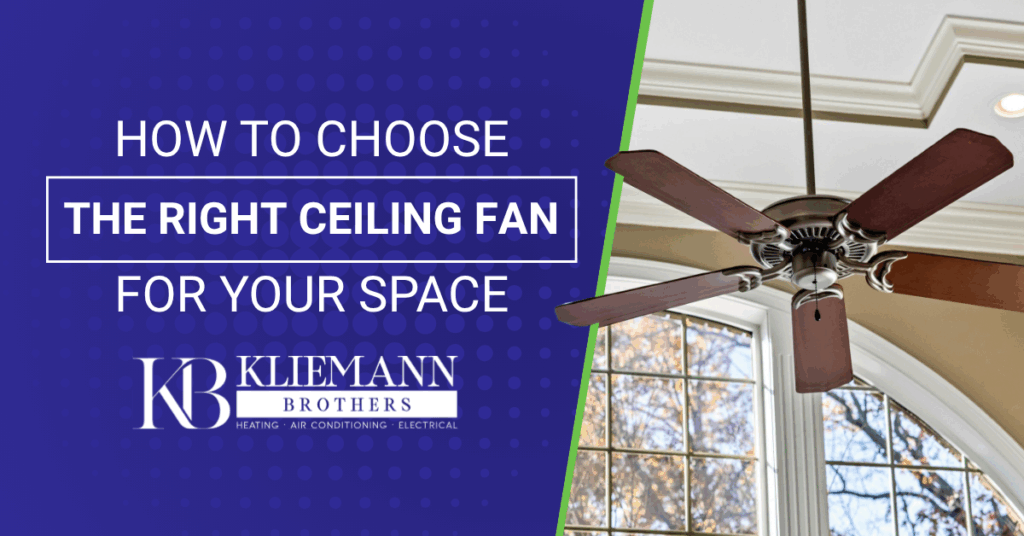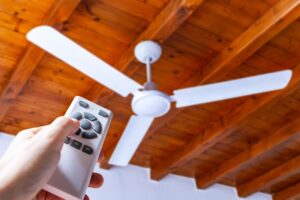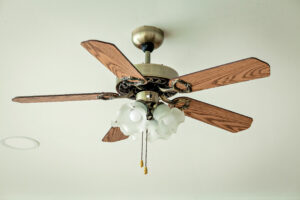How to Choose the Right Ceiling Fan for Your Space

While style is important, your ceiling fan’s size, placement, and features also influence performance. Learn how to choose a ceiling fan that matches your space to improve energy efficiency, enhance comfort, and reduce strain on HVAC equipment. Find everything you need in our ceiling fan buying guide, and receive expert consultations from licensed electricians at Kliemann Bros.

Why Ceiling Fan Selection Matters for Comfort and Efficiency
Ceiling fans don’t lower a room’s actual ambient temperature, but they make it feel cooler by circulating air in your home. This feature enables you to set your thermostat higher on hot days without compromising comfort. Every degree higher on your thermostat translates to significant savings on your cooling costs.
During cold months, switch your ceiling fan direction to spin clockwise at a low speed to push warm air that has risen to the ceiling back down into the living space. This keeps spaces warmer without cranking up your furnace or heat pump, especially in rooms with high ceilings or lofted layouts.
How To Choose the Right Ceiling Fan Size for Your Room
Fan size directly affects how well it circulates air in a room. An undersized fan won’t move enough air, while an overly large fan may overpower the space with noise and turbulence.
General ceiling fan size guidelines
Use these guidelines to determine the ideal ceiling fan diameter according to the square footage of a space:
- Small bathrooms, laundry rooms, closets (up to 75 sq. ft): Use a compact, flush-mount fan ranging from 29 to 36 inches for tighter spaces.
- Bedrooms, home offices, and kitchens (76 to 144 sq. ft): Bedrooms and offices need fans between 36 and 42 inches with quiet motors and dimmable lighting. Kitchens benefit from fans with easy-to-clean finishes.
- Bedrooms and dining rooms (145 to 225 sq. ft): Mid-size fans between 44 and 50 inches offer balanced airflow.
- Living rooms, recreation rooms, and basements (225 to 400 sq. ft.): Choose high-airflow, quiet ceiling fans ranging from 50 to 54 inches for larger spaces.
- Open-concept or large rooms (over 400 sq. ft. — 56″+ fan or multiple fans): Use one large fan or multiple smaller ones spaced apart for open-concept homes or expansive spaces.
Ceiling height considerations
The ideal mounting height is approximately 8 feet from the floor, and rooms with open layouts or high ceilings may require additional airflow support, even if they meet the square footage guidelines. Use these height and mounting guidelines:
- Below 8 ft: Use a flush mount (hugger) fan.
- 8 to 9 ft: Standard downrod mount works well.
- 10 ft or more: Use an extended downrod to bring the fan closer to the living area.
- Sloped ceilings: Use an angled mounting kit to keep the fan level.
Indoor vs. Outdoor Ceiling Fans: What’s the Difference?
Always select a ceiling fan model rated for the specific environment in which you’re installing it. Indoor fans suit dry spaces, while outdoor-rated models can withstand humidity, moisture, and sometimes even direct rainfall. Using the wrong type can cause premature wear and pose safety risks.
Most ceiling fans have labels indicating their UL rating and which conditions they operate safely in:
- Dry-rated: Indoor use only, suitable for bedrooms, living rooms, and other spaces with minimal moisture or humidity.
- Damp-rated: Safe for use in humid areas, such as bathrooms, laundry rooms, or covered patios. Not meant for direct rain.
- Wet-rated: Can handle exposure to rain and moisture. Safe for use on open patios, gazebos, and pergolas that may get wet.
Ratings often depend on the material composition. For example, indoor fans may feature MDF or wooden blades and may warp or crack when exposed to moisture. Outdoor fans use sealed motors, rust-resistant coatings, and plastic or treated wood blades to resist damage from exposure to the elements. Installing fans in high-moisture areas also requires moisture-resistant wiring and weather-sealed mounting hardware to protect against corrosion or electrical shocks.

Key Ceiling Fan Features To Look For
Modern ceiling fans offer a range of features that enhance usability, appearance, and efficiency. Prioritize the best ceiling fan features for your home’s needs:
- Lighting options: Many fans include built-in lights or kits — choose from LEDs, chandeliers, domes, drums, or Edison bulbs.
- Control types: Options include pull chains, wall switches, remotes, and smart controls via phone or home assistant.
- Speeds and reversibility: Look for at least three speeds and a reversible motor for year-round comfort. High-end models may feature dual motors for stronger airflow and better efficiency.
How Blade Count and Design Affect Airflow
The number of blades on a ceiling fan affects both its appearance and performance. Most fans have 3–5 blades, with fewer blades operating with less drag and more blades delivering quieter and smoother breezes.
Otherwise, performance depends more on the motor and overall fan design. For instance, a typical blade angle is between 12 and 15 degrees, with steeper angles pushing more air but requiring a stronger motor. Flatter blades are ideal for smaller rooms or decorative fixtures.
Smart and Energy-Efficient Ceiling Fan Options
Smart home-compatible and energy-efficient ceiling fans deliver long-term value and functionality, ideal for optimizing comfort and reducing electricity bills.
ENERGY STAR-certified fans combine high-efficiency motors with aerodynamic blades and LED lighting to maximize energy savings. Compared to conventional models, ENERGY STAR ceiling fans are up to 60% more efficient.
Fans with smart home integration can connect to your phone, voice assistant, or smart home hub. They offer features such as:
- Custom speed and light settings
- Automated schedules
- Temperature, humidity, or motion sensors
- Remote operation
- Energy monitoring

Trust Kliemann Bros for Ceiling Fan Recommendations and Installation
Kliemann Bros offers expert ceiling fan installation and personalized recommendations to help you choose the best ceiling fan for your space. We guide homeowners through the process of sizing, design selection, and smart feature integration, and our licensed electricians install both indoor and outdoor fans according to code requirements.
Contact us at Kliemann Bros for professional ceiling fan recommendations, installations, and home comfort consultations.

